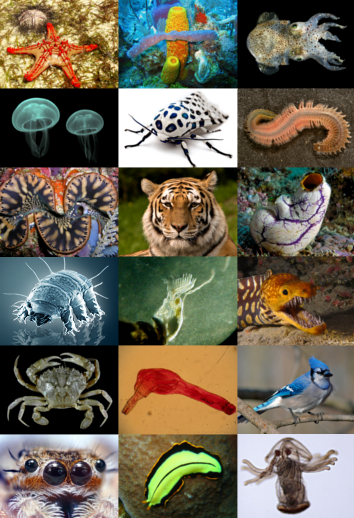
| Palaeos |  |
Metazoa |
| Metazoa | Metazoa Home |
| Page Back | Unit Home | Metazoa References | Metazoa Glossary | Pieces | Page Next |
| Unit Back | Clade Up | Unit Up | Dendrogram | Taxon Index | Unit Next |
LIFE |--Eubacteria `--+--Archaea `--Eukarya |--Chlorobionta `--+--Fungi `--METAZOA |--Choanoflagellata `--Porifera |--Radiata `--+--Cnidaria `--Bilateria |--Deuterostomia `--Protostomia |--Ecdysozoa `--Spiralia |
Quick Links to Major Animal Groups Evolution of the Metazoa Phylogenetic Organization of the Metazoa Some Linnaean Lists |
 |
A. Glossary of terms and abbreviations.
A B C D E F G H I J K L M N O P Q R S T U V W X Y Z
B. Taxon Index: alphabetical list of taxa.
C. References: literature citations by author.
A. Taxonomy
Metazoa - Linnaean classification
B. Dendrograms ("Cladograms")
B. Descriptions
Units marked with an asterisk are placeholders and contain little material. These units will be expanded in due course.
Animalia (Metazoa)*: brief introduction to the animal kingdom
Porifera: the humble sponges, the earliest and most primitive forms of multicelluar animals
Radiata*: animals with radial symmetry, this is just a short unit
Cnidaria*: jellyfish, corals, hydrozoans. An ancient and important group of primitive animals. Corals as reef builders have a particularily rich fossil record
Bilateria: animals with bilateral symmetry, with a head or front and back, and left and right side (lost in some forms, e.g. echinoderms). Includes a discussion on protstome phylogeny
Spiralia: better known as Lophotrochozoa, one of the largest and most diverse clades of animal life. In this unit ancestral Cambrian forms are discussed. The following five or six units are also spiralian
Mollusca*: a very diverse assemblage of mostly generalised spiralians; include chitons, clams, snails, octopii, and many more. Their hard shells have enabled them to leave an extensive fossil record. A large number of subdirectories here but our coverage is currently rather spotty
Annelida*; segmented worms, a more diverse group than most realise. Include tube worms, earthworms, leeches, and many others. The minor phyla Sipuncula and Echiura are related
Brachiopoda*: yet another spiralian taxon, this was an abundant group of Palaeozoic filter feeders, now much reduced. The phoronida may be shellless brachiopods
Polyozoa*: include the Bryozoa and related taxa, may or may not be reated to brachiopods.
Platyzoa*: flatworms, rotifers, gastrotrichs, and other odds and ends, probably an artificial assemblage of assorted miniaturised or simplified spiralians. No fossil record
Chaetognatha*: "Arrow worms", a small group of uncertain affinities, include some conodonts.
Ecdysozoa: "moulting animals", a major group, sister taxon to the Spiralia. This unit includes a general introduction and a review of a number of wormlike and microscopic phyla (Kinorhyncha, Loricifera, Priapulida, Nematoda, Nematomorpha, and Tardigrada) as well as the extant onychophora and paleozoic lobopods and protoarthropods. Also discussion on general ancestry and evolution of teh group
Arthropoda*: animals with a jointed exoskelton, the most speciose phylum of ecdysozoa: trilobites, spiders, crustacea, myriapods, insects and more. AS with mo;l;luscs, this unit includes many subdirectories spotty coverage
Deuterostomia: major group, includes vertebrates, echinoderms, and a number of minor taxa. Discusison here also covers a number of enigmatic Paleozoic forms
Echinodermata*: deuterostomes with secondarily radial symmetry: starfish, sea urchins, crinoids, etc. Extensive fossil record
Hemichordates and Chordates are covered in the next main unit ( Vertebrates)
| Page Back | Page Top | Unit Home | Page Next |
page uploaded 7 April 2002
last modified ATW070725
checked ATW070725